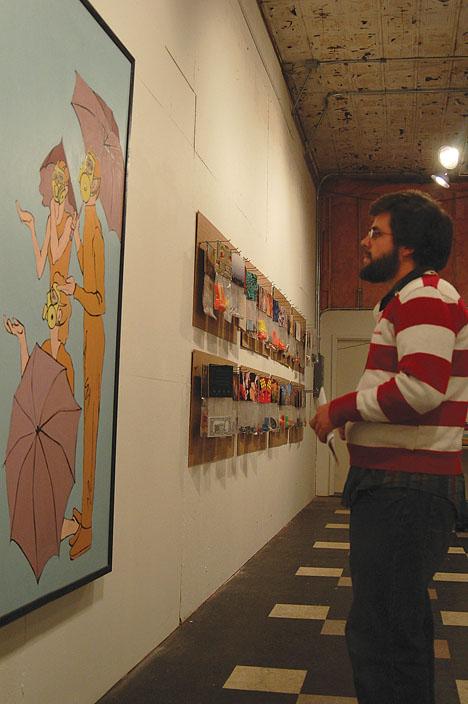Different war eras, views displayed at OpenSource
October 10, 2006
The OpenSource art show, “In War/ At War: the Practice of Everyday,” opened Thursday, Oct. 5 at OpenSource, 12 E. Washington.
I had submitted work to this show, but my work was not chosen for the exhibition. Did this color my views of the show? Absolutely. But even if the committee did not want to hang up a painting of a big blimp of a cartoon decked out in stars and stripes licking a cityscape, I was still interested in seeing what they would choose.
Katee Hendrickson, senior in Art and Design, had a piece, “Vietnam Dad,” which presented a map of Vietnam labeled with specific events, while an audio reel ran stories of Vietnam. Above the reel-to-reel were enlargements of not just photographs, but the cardboard slide holders framing each photo. The assembly was collected from the artist’s father and is not limited to the personal account. The viewer can imagine the maps of other soldiers extending out from the wall. Their stories might lack the theatricality of “Apocalypse Now” but are still just as valid.
In the North Gallery, a long row of pegboard displayed the artist-packaged toys of Mark Cooley, an exhibition participant. Large plastic bags with bright colored labels held plastic guns, police badges, astronauts, and suction-cup arrows – the kinds of toys one might buy in a bait shop or a gas station. Each bag was labeled with the names of countries and the corresponding dates that the U.S. had military involvement with that country.
While the images on the brightly colored labels seemed to be of American products released during the year of military involvement, some of the “products” like Andy Warhol’s Campbell soup can and Disney’s “Beauty and the Beast,” did not add up enough to warrant more than a “eureka” moment. They might have had the labels more accurately simulate the form of toy labels or have had the “toys” actually be for sale.
Get The Daily Illini in your inbox!
Another piece submitted by Dale Lewis displayed drawings solicited in September 2006 at the site of the 2005 London Underground bombing. The artist wanted “people’s opinions of war as expressed through drawing,” and the resulting images and writings encapsulate different takes on war, ranging from the child-like to the more sophisticated. The artist presented blank sheets of paper to re-create the event at the show, but the paper was still labeled “London 2006.” I wondered why it couldn’t be “Champaign 2006” and not a re-creation but an actual event.
The only canvas painting in the show, Judith Covington’s “Acid Test,” had three figures in gas masks under umbrellas. The figures had a woodcut look, like a Soviet Union propaganda poster, but they were still a too little clunky. I liked the choice of colors_the blue was really nice_but neither the surface of the painting nor the line work was enough to suck me into it.
There is also an e-mail on the wall at the exhibit. Jeremy Hight’s “Just Poured Out,” is a print out of an e-mail sent in response to the call for submissions to the show. This simply fell flat. While using some poetic images in the flow-of-consciousness writing, these images were not attached to anything specific. I had no idea who the author/artist was or why I would be reading his e-mail over anyone else’s. Why was a large chunk of the wall devoted to a short e-mail? Information would have helped.
The show’s premise is to investigate “the everyday practices, projects and tactics explored by individuals who cope, adapt and adjust to the climate of war.” With an investigation, I had hoped for a lot more data because we are not just dealing with art, but with discourse on war.
When we already are inundated with death tolls, bombings, and the spinning of facts to distort the truth of our current war, where does art about war fit?
If artists are making art for other artists or making art void of the visual or the aesthetic, the dialogue is going to be very limited as they will not reach much of the general public. Aaron Hughes, an artist and war veteran, arranged a panel discussion after watching war videos Saturday Oct. 7 to bring artists and the general public into the discussion.
Another piece that brought not only discourse but also the visual to the table was Aaron Oldenburg’s “Where are the Diamonds, Mr. President?” A first person shooter video game in which the player is an adolescent African boy toting a gun, this work allows the viewer to navigate a war-torn village rendered in childlike drawings. The player makes choices that can either end the character’s life or bring him to a social worker who tries to learn the story of the warrior child.
Even if I had been accepted into the show, I would have felt the same way about the work. While the show has moments of weakness, there were enough interesting works to keep me there. OpenSource’s goal to continue discourse on war and how it affects all of us is certainly worth a visit to see where we each sit in the dialogue.
The show will be open through Oct. 29. For more information about the show, visit the OpenSource Art Web site at http://opensource.boxwith.com.







